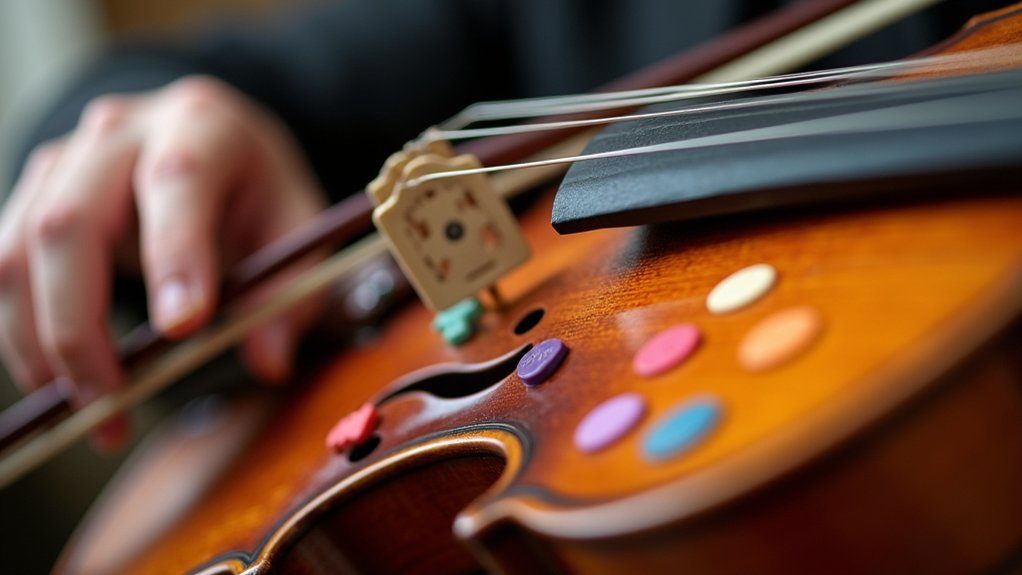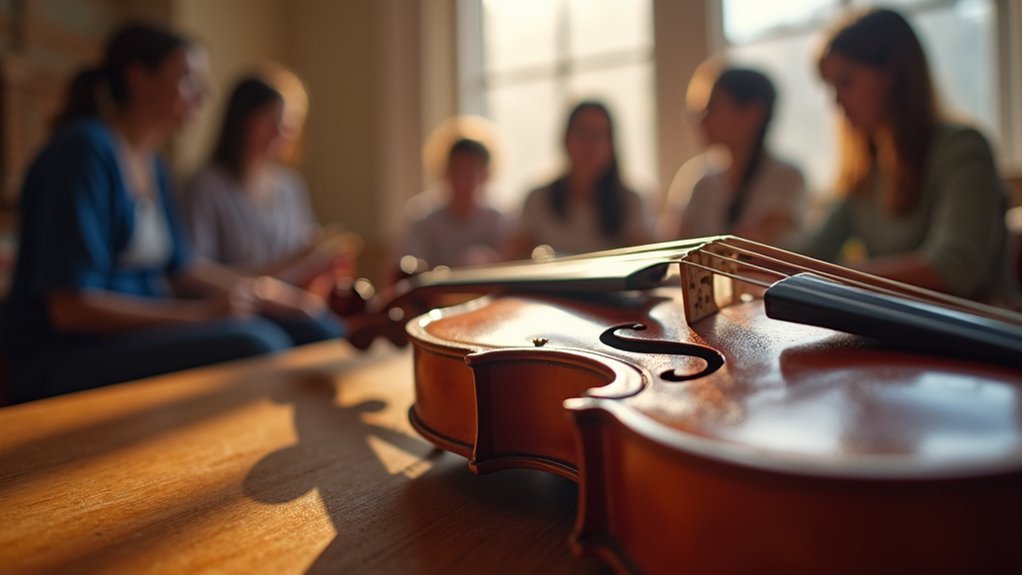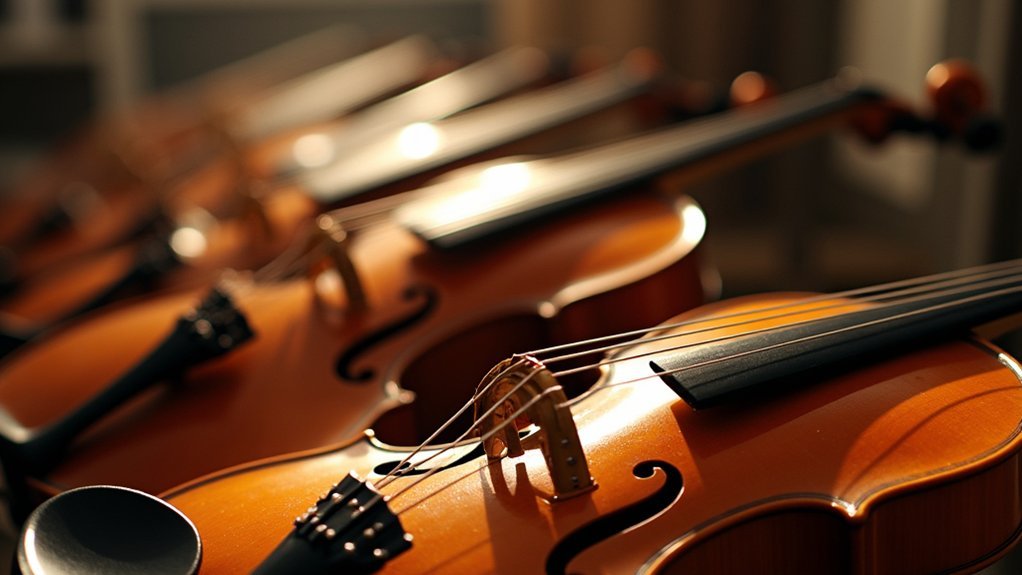Modified string instruments for visually impaired musicians incorporate tactile fingerboard markers, braille notation systems, and innovative designs like the VITAR. You’ll find ergonomic adaptations featuring raised markers and embossed lines to guide finger placement. Technological advances include haptic feedback systems and specialized vibration motors that translate musical elements into physical sensations. These modifications enable independent learning through enhanced sensory feedback rather than visual cues. Discover how these adaptations are transforming accessibility and artistic expression for blind musicians worldwide.
Tactile Fingerboard Markers and String Identifiers

Five key tactile adaptations revolutionize string instruments for visually impaired musicians. Tactile fingerboard markers, made from raised materials, enable you to identify specific fret positions through touch, dramatically improving navigation while playing.
These markers help you develop muscle memory more efficiently, reducing the learning curve.
Tactile markers accelerate muscle memory development, helping you master string instruments with less practice time.
You’ll find string identifiers equally valuable, as they use distinct textures or colors to differentiate between strings. This simple adaptation allows you to locate the correct string instantly by touch.
Both modifications can be customized to your preferences, creating a personalized playing experience.
You’ll gain independence and confidence as you master your instrument through these tactile aids, allowing you to fully participate in musical experiences despite visual impairments.
Braille Notation Systems for String Instruments
Braille notation for string instruments requires you to master tactile score reading through specialized six-dot cells that represent notes, rhythms, and articulations without visual staff lines.
You’ll need to recognize cross-string patterns through touch, with specific symbols indicating string crossings, double stops, and position changes unique to stringed instruments.
These tactile patterns follow consistent logic across different string instruments, though you’ll encounter instrument-specific notation for techniques like pizzicato, col legno, and harmonics.
Tactile Score Reading Fundamentals
While standard musical notation relies on visual symbols, tactile score reading through Braille systems forms the foundation for visually impaired string musicians to access and interpret musical compositions.
You’ll navigate musical elements through a six-dot cell system that represents notes, rhythms, and articulation marks with distinct tactile patterns.
When reading Braille music for your musical instruments, you’ll encounter specific symbols representing note durations—whole, half, and quarter notes—alongside rests and expression marks.
Key and time signatures appear at bar beginnings with unique codes indicating any changes.
Modern resources like braille embossers and digital music readers enhance your learning experience, while raised music notes systems create tactile representations resembling traditional notation.
This all-encompassing approach enables you to independently practice complex compositions and develop proficiency on string instruments despite visual impairments.
Cross-String Braille Patterns
Unlike standard music notation, cross-string braille patterns offer a sophisticated tactile system specifically designed for string instruments.
You’ll find these specialized braille symbols correspond to pitches, rhythms, and techniques unique to string performance, enabling people with disabilities to navigate complex musical landscapes through touch.
When learning these patterns, you’ll discover symbols representing slides, harmonics, and bowing instructions—providing a thorough approach beyond basic notation.
The system excels by creating tactile representations of finger placements and string interactions, essential elements for visually impaired musicians.
Effective learning combines kinesthetic feedback with ear training, connecting tactile braille reading with auditory skills.
This holistic approach guarantees you’ll develop a complete understanding of musical structure while mastering the technical aspects of string instruments through touch.
Ergonomic Adaptations for Enhanced Sensory Feedback

In the domain of adaptive music technology, ergonomic designs have revolutionized how visually impaired musicians experience string instruments. You’ll find these modified musical instruments feature thoughtfully placed embossed lines and raised markers along the body, guiding your finger placement and helping you identify strings through touch alone.
Innovations like the VITAR replace traditional strings with button mechanisms, eliminating tuning challenges while reducing the physical effort needed to play.
These adaptations deliver enhanced sensory feedback by leveraging your heightened tactile and auditory abilities. You’ll also benefit from customizable features such as adjustable string tension and specialized materials that maximize resonance, allowing you to perceive subtle sound differences through vibrations as you play.
Tactile innovations transform instruments into sensory extensions, revealing musical nuances through specialized materials and customizable features.
These thoughtful modifications create a more intuitive, accessible playing experience.
Technological Innovations in Accessible String Instruments
You’ll find technological innovations in string instruments expanding accessibility for visually impaired musicians through tactile fretboard markings that provide orientation without sight.
Sonic guidance systems, like those in the VITAR guitar with its asymmetrical design and embossed lines, offer auditory feedback to replace visual tuning methods.
Haptic rhythm interfaces transform musical timing into physical sensations, allowing you to feel the beat through vibrations rather than relying on visual cues.
Tactile Fretboard Markings
While standard string instruments rely primarily on visual cues for proper finger placement, tactile fretboard markings have revolutionized accessibility for visually impaired musicians.
These specialized modifications provide physical cues through raised dots, embossed lines, or textured surfaces that you can easily identify by touch as you navigate the instrument.
You’ll find these tactile fretboard markings particularly effective when they utilize contrasting materials that stand out from the instrument’s surface.
Many modern adaptations also incorporate the Braille system directly onto the fretboard, allowing you to quickly identify note names and chord shapes without visual reference.
This thoughtful integration of tactile elements promotes greater independence and confidence in your playing, enabling you to focus on expression rather than struggling with positioning challenges.
Sonic Guidance Systems
Three revolutionary sonic guidance systems now complement tactile modifications for visually impaired string musicians. These technologies utilize auditory feedback to help blind people navigate fingerboards with precision and confidence.
The latest systems incorporate sensors that detect finger placement and produce directional sound cues, guiding you to accurate notes without visual reference. You’ll find these features built into many accessible string instruments, allowing for independent learning and performance.
Research confirms that sonic guidance greatly enhances the playing experience for visually impaired musicians, boosting both technical skill and creative expression.
As this technology continues to evolve, you’ll benefit from increasingly responsive feedback that adapts to various musical styles and techniques. These advancements empower you to focus less on finding notes and more on artistic interpretation.
Haptic Rhythm Interfaces
Beyond visual adaptations, haptic rhythm interfaces represent the cutting edge of accessibility technology for string instruments.
You’ll experience rhythm and timing through vibration feedback, allowing you to feel musical patterns directly on your instrument. These systems are particularly valuable for people with motor and visual impairments who benefit from tactile learning approaches.
The latest haptic rhythm interfaces offer:
- Real-time vibration feedback that translates tempo and dynamics into physical sensations you can interpret intuitively
- Integration with modified string instruments using vibration motors and pressure sensors to enhance rhythmic understanding
- Customizable feedback patterns that adapt to your specific learning needs and playing style
These technologies create new pathways for experiencing music, enabling you to develop timing precision and expressive playing through touch-based learning.
The VITAR: A Revolutionary Design for Visually Impaired Players
Among the most innovative adaptations in accessible music technology, the VITAR stands out as a groundbreaking instrument designed specifically for visually impaired musicians. Its asymmetrical shape serves an essential purpose, providing tactile guidance that makes music-making activities accessible to people with mid-visual disabilities.
You’ll find embossed lines carved strategically along the body, acting as navigational landmarks for identifying the instrument’s structure. Unlike traditional guitars, the VITAR replaces strings with buttons, eliminating tuning challenges while simplifying playability. This thoughtful redesign enhances musical engagement for visually impaired players.
The integrated Braille system further enriches the playing experience, allowing you to enjoy guitar-like performance without facing complicated learning barriers.
The VITAR truly transforms how visually impaired musicians can participate in musical creation.
Teaching Methods and Learning Strategies for Blind String Musicians

While traditional music education relies heavily on visual cues, teaching visually impaired string musicians demands creative approaches that leverage alternative senses. Effective teaching methods emphasize ear training and kinesthetic awareness, helping students develop technique through touch and sound rather than sight.
- Use raised music notation systems (similar to Braille) to provide tactile understanding of musical structure during music activities.
- Implement metal bow guides for proper positioning, dramatically improving tone production and technical confidence.
- Personalize instruction based on each student’s unique strengths, adapting strategies to their specific learning style.
The most successful educators remain flexible, combining these approaches to create thorough learning experiences.
Adaptability is the hallmark of exceptional music educators who blend multiple techniques to ensure comprehensive musical development.
You’ll find that by focusing on auditory and tactile feedback, visually impaired students can master string instruments through pathways that accommodate their unique perception of music.
Success Stories: Visually Impaired Musicians Transforming the String Instrument Landscape
Despite facing significant barriers in the music industry, visually impaired string musicians have emerged as powerful innovators who’ve revolutionized both performance techniques and instrument design.
José Feliciano stands out as a trailblazer whose classical guitar mastery has inspired manufacturers to create more accessible instruments.
The development of specialized tools like the VITAR guitar with its braille features and asymmetrical design showcases how musical expression can flourish through thoughtful adaptation. These innovations enable artists to navigate and perform without traditional visual cues.
Community initiatives have amplified these success stories, creating platforms where visually impaired musicians demonstrate their extraordinary talents.
As more professionals gain recognition, the demand for modified string instruments continues to grow, fostering a more inclusive musical landscape where creativity isn’t limited by visual impairment.
Frequently Asked Questions
What Instruments Can a Blind Person Play?
You can play virtually any instrument despite blindness – piano, drums, guitar, wind instruments, or strings. Many instruments have adaptive versions with tactile features, Braille notation, and technology to support your musical journey.
What Are Adaptive Instruments Examples?
You’ll find many adaptive instruments like the VITAR guitar, the button-operated electric guitars, the squeezable Skoog, and the eye-tracking EyeHarp. They’re designed to accommodate various disabilities, allowing everyone to create music.
What Is the Music Technology for the Visually Impaired?
You’ll find various technologies for visually impaired musicians, including Braille notation, eye-tracking systems like EyeHarp, adaptive instruments, and MIDI controllers. Online platforms and specialized textbooks also help you learn music theory independently.
What Is the Easiest Musical Instrument to Play for Adults?
You’ll find the ukulele easiest to learn as an adult. It’s lightweight with just four strings and simple chords. Keyboards, harmonicas, percussion instruments like the cajón, and recorders are also beginner-friendly options.
In Summary
You’ve now seen how modified string instruments can open new musical possibilities for visually impaired musicians. From tactile fingerboard markers to revolutionary designs like the VITAR, these adaptations aren’t just accommodations—they’re gateways to artistic expression. By embracing these innovations, you’ll join a growing community of visually impaired string players who are changing perceptions and creating beautiful music against all odds.





Leave a Reply